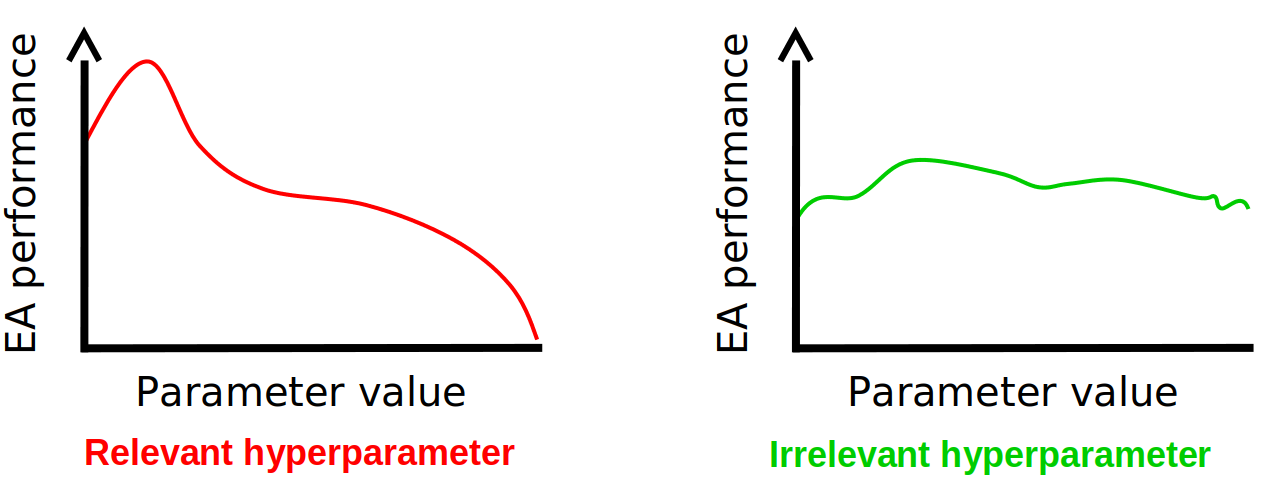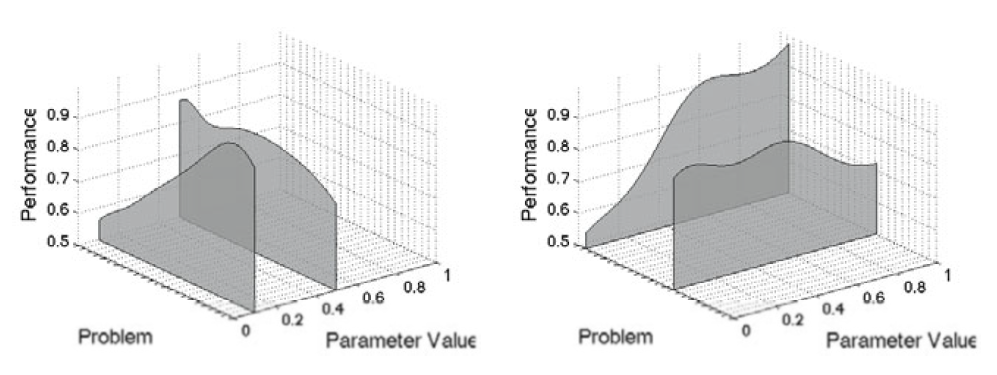15. Tuning Hyperparameters
All the evolutionary computation algorithms used require some form of hyperparameter tuning
Further, given the modular nature of these algorithms, each part of the algorithm is itself a hyperparameter
These may also come with additional hyperparameters that require some tuning
There exists no best way to perform parameter tuning, but there are some common strategies
15.1. Symbolic vs. Numeric Hyperparameters
Symbolic hyperparameters are the modular portions of the algorithms
Crossover operator
Selection strategy
Numeric hyperparameters are the numerical values that can be tuned
Crossover rate
Tournament size
Regardless of the hyperparameter type, their values need to be set
A crossover rate needs to be set
A decision needs to be made on which selection to use
Symbolic hyperparameters may introduce additional numeric hyperparameters
For example, if tournament selection is selected, the tournament size needs to be specified
Typically, symbolic hyperparameters are more high-level
They make up the evolutionary computation algorithm
The numerical hyperparameters are low-level
Specifies the details of the algorithm’s implementation
An evolutionary computation algorithm instance is one that has all the necessary hyperparameters set
15.2. Tuning Hyperparameters
There is no silver bullet strategy strategy for finding the best hyperparameters
Often, some reasonable starting values are selected and then tuned based on the algorithm’s results
15.2.1. Starting Places
There is no correct starting values for any hyperparameters
With experience, a general intuition will form on what is reasonable
Additionally, what one may argue is typical will differ between evolutionary computation algorithms
For a genetic algorithm, common values for variation operators to start with are
Crossover of 80%
Mutation rage of 20%
However, for genetic programming, a mutation rate of 20% would be considered shockingly high
Some symbolic hyperparameter choices may have numerical hyperparameters that need to be set
For example, tournament selection requires a tournament size
A safe starting value for tournament selection is 2
For population size and number of generations, it’s difficult to say as this depends heavily on the problem
For example, was 1,000 generations enough to converge?
If not, try 10,000 generations
If that was not enough, try 100,000
…
Further, some hyperparameter values may need to be adjusted as other hyperparameters are changed
Consider population size
It is reasonable to increase the population size if results improve as it grows
However, depending on the selection strategy used, as population sizes grow, selection pressure may decrease
Thus, if the population size grows, the size of the tournament for tournament selection may need to increase
15.2.2. Empirical Tinkering
Once the hyperparameters are initially set, the algorithm should be run to get a sense of performance
Based on the performance, the hyperparameter values need to be adjusted

Changing the value of hyperparameters may or may not have an impact. When tuning the hyperparameter values, focus on those that appear to make a difference. Note, however, that some hyperparameters may appear to be irrelevant but do matter once other hyperparameter values are changed.
The difficulty here is that the hyperparameters have complex interactions with one another
Increasing population size may require increasing tournament size
Increasing mutation rate may require more generations
Suddenly the crossover rate matters once mutation rate grew past a certain value
To make matters worse, good hyperparameter settings is highly problem dependant

Certain hyperparameter values may work well on one problem, but not other. All tuning must be done per problem.
It is foolish to search for the “best” hyperparameter configuration
There are literally uncountably infinite configurations
It’s a pipe dream
The trick is to run the algorithm repeatedly and tune the hyperparameters until adequate results are obtained
With experience, this process gets easier
Note
Automated algorithms for tuning hyperparameters do exist, but they tend to not be overly popular. Feel free to explore these, but do not be surprised if they end up being less helpful than desired.
15.3. For Next Class
TBD